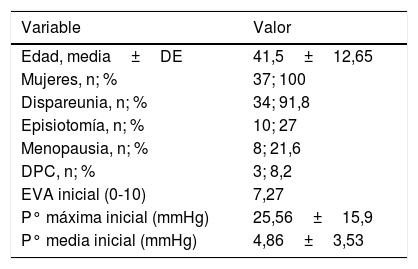Demostrar si un protocolo de rehabilitación multimodal (biofeedback [BFB] más radiofrecuencia [RF] capacitiva-resistiva [INDIBA®]) disminuye el dolor y aumenta la fuerza muscular en los pacientes con dolor pélvico crónico (DPC) y dispareunia.
Material y métodosEstudio prospectivo cuasiexperimental tipo antes-después a 37 pacientes con DPC y/o dispareunia derivados al Servicio de Rehabilitación del Hospital Universitario Santa Cristina (enero-2016 a diciembre-2018). El protocolo consistió en 8 sesiones de ejercicios de musculatura del suelo pélvico asistido con BFB manométrico (ejercicios tónicos/fásicos 15min, respectivamente) supervisado por fisioterapeuta, seguido de RF bipolar capacitiva (5min)/resistiva (10min) a nivel suprapúbico y perineovaginal. Las variables evaluadas fueron el dolor (EVA 0-10) y la fuerza (mmHg) de la musculatura del suelo pélvico al inicio/término del tratamiento.
ResultadosEdad media, 41,5±12,65 años. Es más frecuente entre los 21-40 años (n=20, 54%) y los 41-60 años (n=12; 32.4%). Dispareunia, n=34 (91,8%); DPC inespecífico, n=3 (8,2%). El protocolo mejoró el dolor (de 7,27±1,34 a 3,75±2,21 puntos), la fuerza muscular máxima (de 25,56±15,9mmHg a 35,35±20,4mmHg) y la media (de 4,86±3,53mmHg a 7,18±4,46mmHg), respectivamente (p<0,0001).
ConclusiónEL DPC y la dispareunia suponen un reto diagnóstico que requiere un manejo multidisciplinario. El tratamiento debe iniciarse precozmente y con la asociación de diferentes modalidades terapéuticas. El protocolo de rehabilitación multimodal que incluye al BFB y a la RF capacitiva-resistiva disminuye el dolor y mejora la fuerza en los pacientes con DPC y dispareunia.
To determine whether a multimodal rehabilitation protocol (Biofeedback [BFB] plus capacitive-resistive [INDIBA®] radiofrequency [RF]) reduces pain and increases muscular strength in patients with chronic pelvic pain (CPP) and dyspareunia.
Material and methodsWe performed a prospective, quasi-experimental, before-after study in 37 patients with CPP and/or dyspareunia referred to the Rehabilitation Department of Hospital Universitario Santa Cristina (January 2016 to December 2018). The protocol consisted of 8 sessions of pelvic floor exercises assisted by manometric BFB (15min of tonic/phasic exercises each) supervised by a physiotherapist, followed by suprapubic and perineovaginal bipolar RF [capacitive(5 min)/resistive(10 min)]. The variables evaluated were pain (VAS 0-10) and strength (mmHg) of the pelvic floor musculature and the start/end of the treatment.
ResultsThe mean age was 41.5±12.65 years. The prevalence was higher among women aged 21-40 years (n=20, 54%) and those aged 41-60 years (n=12; 32.4%). Dyspareunia was present in 34 patients (91.8%), and non-specific CPP in 3 (8.2%). The protocol improved pain (from 7.27±1.34 to 3.75±2.21 points), maximal muscular strength (from 25.56±15.9mmHg to 35.35±20.4mmHg) and mean muscular strength (from 4.86±3.53mmHg to 7.18±4.46mmHg) respectively (p<0.0001).
ConclusionCPP and dyspareunia are a diagnostic challenge that requires multidisciplinary management. Treatment should be started early and should consist of distinct therapeutic modalities. The protocol of multimodal rehabilitation including BFB and capacitive-resistive RF reduces pain and improves strength in patients with CPP and dyspareunia.
Artículo
Comprando el artículo el PDF del mismo podrá ser descargado
Precio 19,34 €
Comprar ahora











